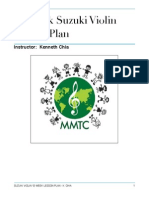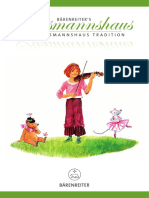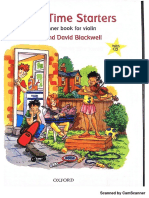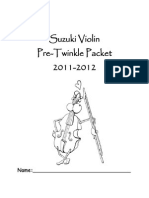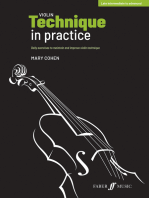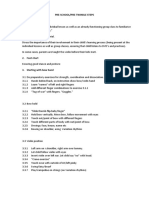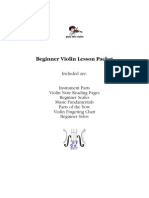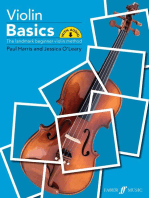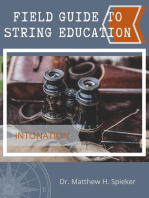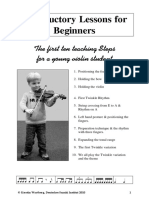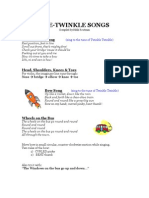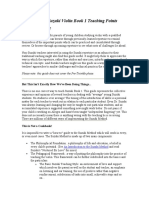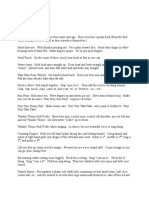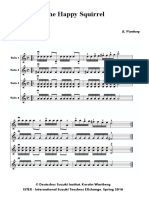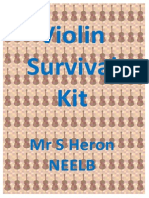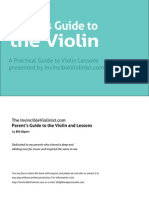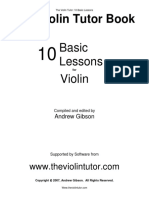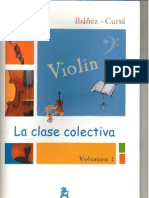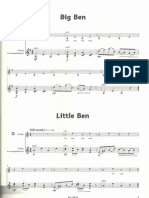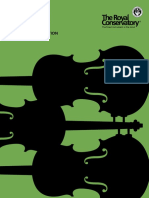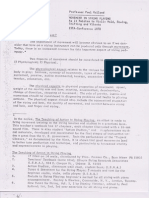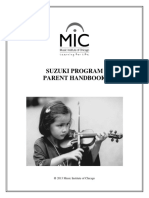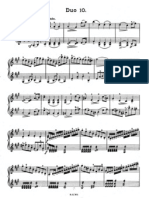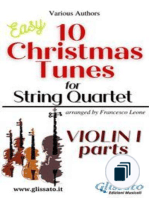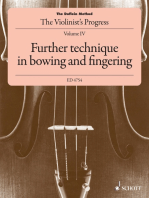Professional Documents
Culture Documents
Violin Stars Study Guide For Suzuki Book 1
Violin Stars Study Guide For Suzuki Book 1
Uploaded by
Tricia Eidissen100%(4)100% found this document useful (4 votes)
546 views24 pagesMusic
Original Title
Violin Stars Study Guide for Suzuki Book 1
Copyright
© © All Rights Reserved
Available Formats
PDF, TXT or read online from Scribd
Share this document
Did you find this document useful?
Is this content inappropriate?
Report this DocumentMusic
Copyright:
© All Rights Reserved
Available Formats
Download as PDF, TXT or read online from Scribd
Download as pdf or txt
100%(4)100% found this document useful (4 votes)
546 views24 pagesViolin Stars Study Guide For Suzuki Book 1
Violin Stars Study Guide For Suzuki Book 1
Uploaded by
Tricia EidissenMusic
Copyright:
© All Rights Reserved
Available Formats
Download as PDF, TXT or read online from Scribd
Download as pdf or txt
You are on page 1of 24
Copyright 2008 Violin Stars
This program may not be copied or reproduced in any
way without permission. Unauthorized uses are an
inringement o the U.S. Copyrights !ct and
are punishable by "aw.
Welcome!
Hi! Welcome to our Violin Stars Study Guide! This course will
help guide you through Suzuki Book 1. This course is not
designed to teach you how to play the iolin! it is meant to "e
used as a study guide #or "ook 1 in addition to your regular
lessons. $# you don%t already know how to play! then you need to
put this course away and #ind a teacher or purchase our "eginner
iolin course. &ou need to hae the "asics down "e#ore you "egin
this program.
'eet &our $nstructors!
(im ) *hristina Walters are your instructors. +s o# ,--.! (im
/,,0 and *hristina /1.0 hae "een playing #or 1 years and
teaching #or 2 years. They hae taught iolin classes in seeral
di##erent schools in their community as well as priate lessons.
Though they are young! they "oth receie high praise #or their
teaching skills and passion #or playing.
(im *hristina
What &ou%ll 3eed
4kay! "e#ore you "egin there are 5ust a #ew things that you will
need. 4"iously you will need your iolin and "ow! But you will
also need a music stand and a copy o# Suzuki Book 1. $# you
need a copy o# Book 1 you can get one in most music stores! or
"uy one o## o# our we"site www.iolinstars.com
How to use this course
Be#ore you "egin studying a certain piece $ would recommend
that you watch the 6V6 #irst. +nd go ahead and watch the entire
ideo een i# you aren%t working on some o# the harder pieces yet.
$t%s good to see and hear them "ecause it will help you learn them
#aster when you "egin working on them. $t would also "e help#ul
#or you to mark the measure num"ers in your "ook! mine doesn%t
hae them so $ wrote them in. That way we can communicate
"etter. 7or e8ample! 9ightly :ow has 1; measures! so i# $ wanted
to gie you a tip #or measure 1- you could <uickly #ind it i# you
hae it wrote in. $# you don%t een know what $%m talking a"out
then you need to learn some "asic theory right now! $# that is so
then try this link www.teoria.com +nd go through some o# their
#ree tutorials. +lso i# you don%t know the names o# the notes then
go through your pieces and write the names a"oe the notes.
+gain! the Teoria site can help you learn the note names i# you
need help.
$# you are 5ust "eginning Book 1! then this is where you start! $
like to call Variation + Huckle"erry =ancake. The main tip $ can
gie you #or this piece is to always remem"er to stop the "ow
"e#ore changing strings! That means i# you are on the > string!
stop the "ow "e#ore you moe to the + string. This will also gie
your #ingers time to #ind their correct places on the string as
well. Wheneer you go #rom the open > to the ?
rd
#inger on the
+ string! put the other two #ingers down as well. Since you will
"e using your ,
nd
#inger right a#ter the ?
rd
#inger it makes sense
to already hae it down and ready to play. This is called "lock
#ingering. Stopping the "ow "e#ore changing strings will gie you
the time you need to sort your #ingers out. *hristina will
demonstrate Twinkle on the ideo with the "ow stopping "e#ore
she changes strings! and as the "ow stops you will see her
<uickly place her #ingers as well. This is the secret to producing
a clean sounding tone. 4nly when you are ready! should you
attempt Twinkle without the stops. $# you hae done your
homework you will make the transition ery smoothly!
We call Variation B 'ama 4h 'ama. $# you look at the notes you
will see two .
th
notes grouped together @ an .
th
note rest @ then
one .
th
note "y itsel# and then two more .
th
notes grouped
together. /+gain! i# you hae no idea what $%m talking a"out! you
"etter "uy yoursel# a "eginner%s theory "ook or check out
www.teoria.com0 So the #irst two .
th
notes represent 'ama A the
.
th
note rest is silent @ the single .
th
note is where we say B4hC
and the last two that are grouped together are 'ama. $t is
help#ul to sni## during the rest. $t helps you time it "etter. So it
would go like this B'ama %Sni##% 4h 'ama %Sni##% etc. +gain
remem"er to stop the "ow "etween string crossings. +nd each
note should "e short and crisp. 6on%t use a lot o# "ow! and make
sure you stay in the middle o# your "ow.
Variation * we call 6own =ony Dp =ony. This one is #airly simple
to get the hang o#. &ou can also say 6own Tiny Dp Tiny $# you
look at the notes you will notice that each set o# notes consists o#
an .
th
note connected to two 1;
th
notes. The .
th
note represents
the 6own and the two 1;
th
notes stand #or =ony. &ou can use a
little more "ow on the .
th
notes! "ut use a tiny stroke #or the 1;
th
notes. $# none o# this is making sense! don%t worry! you%ll know
what $ mean when you watch the ideo.
Variation 6 we call %Wish $ had a motorcycle%. &ou will notice that
the notes are grouped into sets o# #our 1;
th
notes. The trick to
this one is keeping your "ow hand ery loose and rela8ed. 4nly
use a small amount o# "ow. &ou can try playing this ariation
while sitting on your "ed to get a "ouncy #eel that will help you
lighten up and rela8.
The #inal Variation is Twinkle Theme. This one /though it appears
easier than the rest0 can "e di##icult to master. &ou need to hae
a"solute control oer your "ow. 6on%t try to use a whole lot o#
"ow at #irst. Start out with a tiny amount o# "ow and then
gradually "uild up to more and more "ow. $t%s important not to
press too hard or too lightly. 'any children push too hard and
strangle the strings! while adults /#earing a "ad sound0 o#ten
press too lightly which produces a distorted whistling tone. Try
to think o# the weight o# your arm sinking into the string. +nd
instead o# #orcing the tone out try to draw the tone out. Bowing
on the iolin is like petting a cat or dog! i# you push too hard
they might growl at you /#unny! so does the iolin . . . 0 and i#
you only lightly run your hand oer the top o# their #ur you%ll 5ust
tickle them. +nimals like to "e stroked which means you use an
een pressure! it #eels good to them! and the iolin likes it too.
$t%s always so e8citing to moe onto 9ightly :ow a#ter mastering
all o# the Twinkle Variations! 9ightly :ow is not a di##icult little
tune! especially i# you did your homework with Twinkle. The main
thing to remem"er is to stop the "ow "etween string crossings.
Stop the "ow a#ter each note while you are learning. 4nce your
#ingers #igure out what to do then you can take away the stops!
"ut i# at any time you start getting a distorted sound then you
need to slow way down and gie yoursel# plenty o# time "etween
each note.
Song o# the Wind presents us with a couple o# new challenges.
The #irst challenge is in measure ?. See the num"er 1 with a
long line underneath the notesE That means that they want you
to hold your #irst #inger down #or that entire measure. 'easure
? "egins with the 1
st
#inger held down on the > string /the note is
7F0 and while the 1
st
#inger stays down! the ?
rd
#inger can hop
oer to the + string! and then it will hop "ack to the > string and
then #inally it will li#t o## and the 1
st
#inger on > will play again.
So the passage goes 1 A? A? A1 A> +nd the #irst #inger stays
down #or the whole measure. Then we come to measure 2 where
we encounter our ne8t challenge. + <uarter note rest. So use a
lot o# "ow on the <uarter note > in measure 2 and then li#t your
"ow o## o# the string during the rest and land "ack on the string
lightly near the #rog. This takes practice! Try to make a circling
motion when you li#t your "ow o## o# the string and then lightly
land "ack on the string a little ways a"oe the #rog. $# you land
in the middle o# the "ow or near the tip you will get a "ig loud
*runch when you land! But you want to land silently so practice
until you get it right. +lso make sure your "ow is completely
stopped "e#ore you try to moe it. $# you try to play as your "ow
is landing! you%ll get a distorted scratchy sound. 'easure 1 is a
repeat o# measure ? so you get to do it again! :emem"er to li#t
the "ow when you see that rest. +lways start down "ow a#ter
completing the li#t.
+#ter completing Song o# the Wind! Go Tell +unt :hody usually
#eels pretty simple. There is nothing complicated in this little
tune so it is a good one #or you to practice your "owing on.
:emem"er to stroke the string! try to create a singing tone. This
takes some e8perimenting so play around with it until you #ind the
right "ow pressure. &ou can also try some dynamics! try playing
part o# the tune a little so#ter and then "uild the olume "ack up
#or the ending. Be creatie! +nd here%s a tip! to play so#ter!
moe the "ow closer to the #inger"oard! and to play louder moe
the "ow closer to the "ridge. +gain! you will need to e8periment!
This one is tricky! See that V shape a"oe the note in the 1
st
measureE That means %up "ow% So you will "egin up "ow. Dntil
this point! we hae always "egan with a down "ow. So start in
a"out the middle o# the "ow! you don%t want to "e down at the
#rog or you won%t hae any "ow le#t to go up with! $n measure ,
that #unny little shape a"oe the > means down "ow! which makes
sense since our #irst note was up "ow. + iolinist must learn to
#ollow "owings ery care#ully "ecause they can get <uite
complicated at times. +nd i# you eer play in an orchestra
eeryone%s "ow must go in the same direction. So pay ery
care#ul attention to the "owings! they are the hardest part o# this
tune. +nd do stop the "ow i# you need to "etween string
crossings. $t%s "etter to go slow and do it right! then #ast and
sloppy.
3ow on the ne8t page we hae a tonalization e8ercise. The point
o# the e8ercise is to gie the open string a good strong pluck and
then listen to the sound o# the i"rating string. Then take your
"ow and try to produce the same #ull tone as you did when you
plucked.
$ loe 'ay Song "ecause my "irthday is in 'ay! $n 'ay Song
we make our #irst encounter with the dotted <uarter note. There
is a real good tutorial a"out the dotted note at www.teoria.com
So i# you get con#used check it out. The rhythm is not that hard
though! so 5ust watch the 6V6 and listen to how it goes and you
shouldn%t hae too much trou"le with it.
9ong 9ong +go can "e tricky "ecause it introduces us to the 6
string and we need to use longer "ow strokes #or some o# the
notes. $# you look at the 1
st
measure! you will play the open +
note with a long down "ow! then you will play the two .
th
notes
with tiny "ow strokes and then the ,
nd
#inger *F will "e a long up
"ow. So this pattern 5ust repeats oer and oer again #or the
whole tune. 9ong . . . Tiny . . . 9ong . . . Tiny . . . 9ong . . .
Tiny . . . 9ong +nd then sometimes we hae a hal# note which is
e8tra long! $# the 6 string #eels di##icult #or you! try playing some
o# your more #amiliar tunes! like Twinkle on the 6 string. That
will help you get more com#orta"le with it.
+llegro is a #un little tune. $t is in the key o# + 'a5or! 5ust like
all o# the other pieces that we hae played. How can $ tell that it
is in + 'a5orE Well there are three sharps right "y the tre"le
cle# in the #irst measure! so that tells me that it is in + 'a5or.
The amount o# sharps or #lats that are shown "y the tre"le cle# is
called your %key signature% So in + ma5or all o# our 7! *! and G
notes are sharp. 7or more in#o on this su"5ect you can checkout
www.teoria.com They hae a lot o# great in#ormation and it%s all
#ree! 3ow! a"out this piece. $n the #irst measure you will notice
that there is a dot a"oe each note. Those are staccato dots!
which means the "ow needs to "e stopped a#ter each note to make
a crisp sound. $n measure , the group o# #our .
th
notes do not
hae dots! so you can play those smoothly. 'ake sure you
practice that measure slowly and care#ully "ecause those 2 little
notes can "e <uite a hand#ul #or most students! $# you #ind
yoursel# haing pro"lems then take measures 1 and , and 5ust
slowly repeat them oer and oer again until your #ingers rela8
and #igure out what to do. 'ake a song out o# 5ust those two
measures! $n measure 2 you get another group o# #our .
th
notes
so do the same thing! take your time and stop the "ow "etween
each note until your #ingers rela8. $n measure G you will notice
the word %dolce% 6olce means %sweetly% so you can use more "ow
#or the ne8t #our measures and try to create a sweet singing tone.
When you get to the last measure you will see %rit.% which means
slow down. There is also a decrescendo marking underneath the
rit. So that means you can get so#ter. &ou may hold the last note
in that measure #or as long as you want to create some
suspense . . . and then li#t the "ow and make a "ig snappy
entrance in measure 1?! This is where the main theme returns
and it is marked 7 which is short #or 7orte and means to play
loud!
=erpetual 'otion is is the #irst piece that you get to "egin using
your 2
th
#inger on. &ou will notice that you now hae two options
oer all o# the open string notes. 9ook at measure ,! you will
notice that there is a - a"oe the > note and also a 2 a"oe the
>. So you could play the note with your open > string! "ut they
would rather hae you use your 2
th
#inger. $# you see an > note
with only a - oer it! then that means you are not e8pected to use
your 2
th
#inger and they would like you to use your open > string
instead. *on#using $ know! But wheneer you see that 2 a"oe a
note! use that #inger! $t takes a while to "uild up strength in the
pinkie and this piece is an e8cellent one to use #or that. When
you #irst "egin working on this piece! you will need to stop the
"ow a#ter each note and go ery slowly until you are #eeling pretty
com#orta"le with it. $# you run into a measure that #rustrates
you! then go een slower and repeat that measure seeral times in
a row until the pro"lem clears up. &ou need to "e ery patient
with your #ingers #or this piece and gie them plenty o# time.
4nce you are #eeling con#ident then you can try playing the piece
using Variation B shown on the ,
nd
page. So instead o# using .
th
notes! you will "e playing using all 1;
th
notes. This will mean you
need to repeat each note. :emem"er to keep that "ouncy #eeling
in your wrist. +nd in the "eginning it is good to stop the "ow
"etween each note. So in measure 1 you would play ++ rest BB
rest *F*F :est *F*F so each note now gets played twice. When
you get this down good then you can take out the stops and play
through the whole piece smoothly using 1;
th
notes. The key to
playing #ast is staying rela8ed! So do not push yoursel#! go ery
slowly and gradually "uild up speed.
4n the ne8t page you will #ind some e8ercises #or your 2
th
#inger!
a tonalization e8ercise and a 6 'a5or Scale. Take a look at the
key signature! you will notice that there are two sharps. That is
the key signature #or 6 'a5or and it means that all o# our 7 and
* notes are sharp. Howeer our G notes are not sharp! as in +
'a5or.
+llegretto can "e tricky "ecause we are now mainly on the 6
string! we hae to use our 2
th
#inger! and there are een some
notes on the G string! +lmost eery note in the piece has a
staccato dot underneath it so that means that we need to use a
short crisp "ow stroke. Whereer you see a 2 a"oe a note! make
sure you use your 2
th
#inger! We also hae some accents! those
are those little arrow looking things underneath some o# the
notes. That means that you can gie that note a little "it o# "ite
with your "ow. So moe the "ow #aster on the notes with accents
and make sure you only use the %"ite% at the ery "eginning o# the
note! then let it #ade. Toward the ,
nd
hal# o# the piece we hae a
rit. So you can slow way down right there! as much as you like!
make it sound really dramatic! +nd then go "ack to the short
crisp staccato strokes to #inish the piece.
This piece is similar to +llegretto. $t is in 6 'a5or as is
+llegretto and we use a lot o# the same notes and rhythms.
Howeer! we don%t hae as many staccato notes. &ou will notice
that in measure 1 the #irst two .
th
notes do not hae a dot! so
they can "e played smoothly! howeer the <uarter note #ollowing
them does hae a dot so it needs to "e short and crisp. So we
hae a pattern that repeats throughout the whole piece. Two
smooth .
th
notes #ollowed "y a staccato <uarter note. Then in
measure G the romantic part o# the piece "egins. $t is marked
7orte and there are no staccato dots. So this means that you
can use a lot o# "ow and really draw out the tone. 'ake it sing!
=lay with a "ig #ull tone and then . . . when you come to measure
1, where the rit. $s slow way down and get so#ter until your tone
nearly dies away . . . "ut wait! there%s more . . . 5ust "e#ore you
completely #ade! come "ack in at the %a tempo% and "uild up to
your #inal ending where you can use a "ig rit. Begin slowing
down in the measure "e#ore the last one to create a really
dramatic ending.
$ always #ind it #unny that there is a piece actually named %>tude%
"ecause adanced iolinists study entire "ooks #ull o# etudes.
+nd etude is usually 5ust a technical piece used to increase your
techni<ue! they are similar to scales! only more interesting. So
#or you Book 1 students! here is your ery #irst /o# many0 etudes!
This piece is tricky "ecause it is in G 'a5or. $ hope you
practiced that G 'a5or scale at the top o# your page. 6id you
notice the ,%s with a circle around themE That means that your
,
nd
#inger goes right ne8t to your #irst #inger. $t will #eel a lot
di##erent! so gie yoursel# plenty o# time to get used to it. $n G
'a5or we only hae one sharp so you won%t hae *F%s on the +
string anymore! instead your ,
nd
#inger will snuggle right ne8t to
your 1
st
#inger to produce a * natural. The same thing happens
on the > string. 3o more ,
nd
#inger GF%s instead the ,
nd
#inger
tucks itsel# in right "y the 1
st
#inger to produce a G natural.
*on#using! $ know! But you%ll get it. So you can study this piece
the same way you did =erpetual 'otion. To "egin! stop the "ow
a#ter eery note so that you can prepare your #ingers. &ou may
#ind it di##icult to reach with the 2
th
#inger now that your ,
nd
#inger is pulled "ack ne8t to the 1
st
. 6on%t gie up i# that happens!
5ust reach as #ar as you can! and "ring your thum" way
underneath the neck o# the iolin. Try not to stick your wrist out
"ackwards! as you reach! rather "ring your wrist in towards the
instrument. $# you need more help! ask your teacher #or adice!
or email me zclipseHem"ar<mail.com +s a "eginner $ had seere
pro"lems with the 2
th
#inger! so much so that my own teachers
were stumped as to what to do! So $ hae deeloped a lot o#
tricks and strategies that will help with 2
th
#inger pro"lems. The
"iggest trick to mastering this piece is remem"ering where all o#
the low ,
nd
#inger notes are. So go through your notes and circle
all o# the notes that you need to use your low ,
nd
#inger on! to
help you remem"er. +nd "e care#ul "ecause the ,
nd
#inger notes
on the 6 and G strings are not low. $# you hae studied your G
'a5or scale! this shouldn%t "e di##icult.
Wow! We%e made it to the 'inuets. 3ow we%re into the %"ig kid%
pieces! The 'inuets are challenging! "ut so "eauti#ul and #un to
play. 'inuet 1 is in G 'a5or! so i# you #igured out where all o#
those low ,
nd
#inger notes were in >tude! then you should pick up
the #ingering in 'inuet 1 pretty easily. $n the ery #irst measure
we encounter a new challenge. Hooked "owing. That%s when we
play two notes with the same "ow stroke. 6o you see that cured
line connecting the two notes in measure 1E That line tells you to
play "oth o# those notes in the same "ow stroke. +lso notice the
dots oer the notesE Those are our staccato dots so that means
we stop the "ow "etween each note! that way you can clearly hear
each note een though they "oth went up "ow. &ou can practice
the rhythm o# the #irst measure on an open string. 6own Dp Dp.
6own Dp Dp. 6own Dp Dp. +nd that will help you get the #eel o#
it. The same pattern happens again in measure ?. $n measure .
you will see that we hae a dotted hal# note. That%s a long note!
$t%s worth three "eats so make sure that you hold it long enough.
$n measure 1- we hae an %accidental note% &ou will notice a F
sign ne8t to the ,
nd
#inger *. That means that #or that measure
only the * is sharp and so you will place your ,
nd
#inger right
ne8t to the third. The same thing happens again in measure 1,.
+n accidental sharp or #lat can appear in a measure at any time!
howeer it%s only good #or that one measure! and then the "ar
line will cancel it. There are a lot o# tricky eighth notes in this
piece! so "e sure to take your time and play each set o# eighth
notes ery slowly! stopping the "ow "etween each note until you
get the hang o# it. &ou neer want to rush yoursel#! and i# you
take the time now! you%ll "e playing the piece up to tempo in no
time!
This piece introduces us to some more di##icult string crossing
and it "egins in the ery #irst measure! Be#ore you try playing
the notes! try playing the pattern o# the #irst two measures using
only open strings. So it would go like this 6 @ + @ + @ > A +
A> @ > @ 6 @ 6 That way your "ow can get the hang o# it
"e#ore you een mess with trying to teach your #ingers their 5o"!
+#ter you teach your "ow what to do! go ahead and set it down
and play the actual notes this time! "ut 5ust pluck the strings.
That way your #ingers can learn the notes without you haing to
think a"out your "ow as well. Then once you know the notes! try
putting the two together and play the notes using the "ow. +gain!
go ery slowly and stop the "ow a#ter each note while you%re
learning. Stopping the "ow is the "est thing you can do #or
yoursel#! +"out G1 percent o# "eginners usually ignore those
directions! and as a result they end up sounding distorted and
scratchy. $n measure 11 we hae a new rhythm @ a triplet. See
the three .
th
notes grouped together with the num"er ?
underneath themE That ? doesn%t stand #or a #ingering! it means
that that group o# notes is a triplet. + triplet means that you #it
three eighth notes into the length o# a <uarter note. 3ormally we
can only #it two eighth notes into the length o# a <uarter note.
So how do we get three to #itE Well each note has to "e a little
#aster than a normal .
th
note. &ou can #ind more in#ormation
a"out this on the Teoria site. +nd it%s actually not as complicated
as it sounds. Iust watch the ideo and you%ll get the hang o# the
rhythm 5ust "y listening. Howeer! another tricky thing a"out that
triplet is all three notes are slurred together! That means you
hae to play all three o# them on one down "ow. They don%t hae
dots so they aren%t staccato! "ut while you%re learning to slur
them! pretend that there is dots and stop the "ow a#ter each note.
So that you go down @ down @ down +nd when that #eels easy
then take the staccato away and try slurring them together in one
smooth "ow stroke. $n measure 1. and ,- we hae some more
hooked "owing! "ut you remem"er how to do that. Both notes go
up "ow! "ut there is a space in "etween them since they hae
staccato dots. $n measure ,? we hae another triplet. So that
means those three .
th
notes e<ual one "eat. Then we hae
another surprise in measure ,? @ a high ?
rd
#inger. See that F
sign ne8t to the ?
rd
#inger 6E That%s an accidental! so that means
you hae to stretch that #inger a hal# step higher than you
normally would. $n measure ,2 you hae a 2
th
#inger > note! so
i# you played your 6F correctly then your ?
rd
#inger should hae
"een right ne8t to the 2
th
#inger. $ hope that makes sense. $# not
then ask your teacher! or email me. $n measure ,1 there is a
natural sign ne8t to the ?
rd
#inger 6 so that means that it is "ack
to 6 natural which is 5ust normal ?
rd
#inger. $n measure ,G we
hae two slurred <uarter notes #ollowed "y a staccato <uarter
note. So play those two slurred notes ery smoothly in one "ow
stroke and then make that staccato note sound ery crisp. Dse a
heaier slower "ow stroke #or the two slurred notes and a lighter
#aster "ow stroke #or the staccato note. 4nce you get through
that section you are "ack into #amiliar territory as you repeat the
theme #rom the "eginning.
This is a "eauti#ul piece. *hristina and $ played this as our #irst
solo the #irst year we "egan learning iolin so this is one o# our
#aorite pieces. $t%s not real tricky. $t uses all o# the techni<ue
that you learned in the other two minuets. There are some slurs
and hooked "owings. There are also a couple o# accidentals! so
"e aware o# those. $n measure . that little tiny note is called a
grace note! which is a type o# ornament that we occasionally use
in our playing. $t can "e played either "e#ore the "eat or on the
"eat! "ut either way it will take away a tiny "it o# time #rom the
dotted hal# note. &ou%ll get the hang o# it when you listen to how
it goes. 4ther than that! $ don%t think there is much o# anything
too tricky. Iust practice slowly and care#ully using all o# the
techni<ues that $ hae taught you.
This can "e a tricky little tune. $t has lots o# hooked and slurred
notes plus lots o# tricky string crossing. So "e prepared to
spend some time on this one! $ would practice a lot o# it on open
strings #irst and leae the #ingers out o# it. So the #irst three
measures would go like this i# $ were using only open strings 6 @
6 A+A + @ 6 @ + A> A> A> @ +A +A +nd so on. So that way
$%m teaching my "ow e8actly what it needs to do! "ut $%m 5ust
using the open strings and not worrying a"out playing the
#ingered notes. 3e8t! $ would pro"a"ly set the "ow down and 5ust
pluck the notes while teaching my le#t hand how to #inger all o#
the notes. 7inally $ would put the two together! "ut $ would stop
the "ow "etween each note while $ was learning. $n measure G we
hae a <uarter note slurred into a staccato .
th
note. There%s also
an accent a"oe the <uarter note. So moe the "ow #aster right
at the ery "eginning o# the <uarter note so that you can hear
that accent! then let it #ade. 'ake sure you don%t #orget the
staccato on the .
th
note. +lso notice the accent a"oe the .
th
note
in measure 1-. So gie that note a little "it more %"ite% so that it
sounds di##erent than the others.
This last piece in Book 1 is a ery di##icult piece. 'ost students
work on it until they can do the "est they can! and then they
moe onto Book ,. &ou may "e nearly #inished with Book , "y
the time you completely master this Gaotte! So don%t think you
hae to play it per#ectly! 5ust do the "est you can do and gie it
time! "ecause it%s a tough one. The #irst measure "egins with
staccato so play each note with short sticky "ow strokes. $n
measure , there is a grace note which is played ery <uickly.
9ook at the ne8t page #or some practice e8ercises. $n measure J
we hae an accidental on the G string. See the F sign "y the *
noteE That means it%s a high ?
rd
#inger. They also hae a 2
a"oe the note. That means that you could also play it with a low
2
th
#inger. $# you chose to use that #ingering then your 2
th
#inger
would land right ne8t to your third #inger i# it were in it%s normal
position. So you can use either a stretched ?
rd
#inger or a low 2
th
#inger. $t%s your choice. +s you adance in your playing you will
learn that there are many di##erent ways that you can #inger a
gien note. The trick is to #ind the #ingering that works "est #or
that particular passage.
The dramatic part o# the piece "egins in the second hal# where it
is marked %piu canta"ile% This means %singing% So make it shine!
The lines a"oe the notes are %tenuto% marks. This means to play
the note #or its #ull alue! "ut to also separate it #rom the other
notes. Sort o# emphasize each note. When you get to measure
,- you run into a tricky little passage o# 1;
th
notes. &ou will see
an e8ercise on the #ollowing page o# your "ook that will help you
with this passage. What you need to do in the "eginning is leae
out the slur and play each note separately. +lso notice that in the
#irst group o# 1;
th
notes there is a ,
nd
#inger *F "ut in the
second group o# 1;
th
notes the *F changes to * natural. So in
the #irst group you hae a normal ,
nd
#inger! and then in the
second group you hae a low ,
nd
#inger. This is hard enough #or
the "rain! "ut then to hae to slur them altogether as wellE!E
So take your time! and don%t #eel "ad i# you struggle with it
"ecause this is usually eeryone%s %3ightmare =assage%! $t is
normal to still "e trying to per#ect that passage while you%re
working through Book ,. +nd there%s nothing wrong with that.
=ay attention to those hooked .
th
notes in measure ,1. They
shouldn%t gie you too much trou"le. $n measure ,2 you hae
another group o# 1;
th
notes to practice slurring. They aren%t as
hard as %The 3ightmare =assage% though so 5ust take your time
with them! and practice without the slur at #irst. $n the ne8t
section there are more slurred 1;
th
notes along with some
staccato <uarter notes that hae some tricky string crossing.
Iust go ery slowly and care#ully. &ou hae practiced string
crossing in other pieces so you should "e a"le to #igure this out
as well. $n the #inal two measures you hae two up "ows and
then to pizz. 3otes. =izz. 'eans to pluck with your right hand.
So instead o# using the "ow! you pluck those two notes which
adds a special e##ect to the piece! Take adantage o# those two up
"ows! they are there #or a reason @ they can help you get to the
#rog o# your "ow which makes it much easier to pluck the ne8t
two notes. &ou%ll notice that there is no rest "etween the "owed
notes and the pizz notes! So there is no time #or messing
around. Get to your #rog and then li#t your inde8 #inger o## o#
the "ow! without changing the rest o# your "ow hold! and use that
#inger to per#orm the pizz. $t takes some practice "e#ore you can
do it smoothly! +t #irst you may end up nearly dropping your
"ow or plucking the wrong strings! 6on%t worry i# you do! it%s
normal! +#ter that you repeat the "eginning o# the piece again
until you come to the word %7ine% which means the end!
This completes our study o# Suzuki Book 1! $ hope you had #un
working through the "ook! &ou are now ready #or Book ,. $#
you hae any <uestions you can email me at
zclipseHem"ar<mail.com +nd also don%t #orget to check out our
we"site www.iolinstars.com 7or all o# our latest news!
You might also like
- Suzuki Violin 12-Week Lesson Plan KC-MMTCDocument15 pagesSuzuki Violin 12-Week Lesson Plan KC-MMTCKenneth Chia90% (21)
- Lullabies, Action Songs and RhymesDocument9 pagesLullabies, Action Songs and Rhymesrapha100% (1)
- SPA150 Sass Eng 2015Document16 pagesSPA150 Sass Eng 2015Nima Taghavi17% (23)
- Fiddle Time StartersDocument40 pagesFiddle Time StartersIgnasia Soledad Carrillo Muñoz100% (14)
- Violin String BeginningDocument58 pagesViolin String BeginningJorge Morales Cárdenas100% (5)
- Stepping Stones Cello PDF FreeDocument8 pagesStepping Stones Cello PDF Freeluca lucadelta 2004100% (1)
- Suzuki Violin Pre-Twinkle Packet 2011-2012: NameDocument14 pagesSuzuki Violin Pre-Twinkle Packet 2011-2012: NameJessica Duas100% (10)
- 358 Pre-Twinkle Ebook 29pagesDocument29 pages358 Pre-Twinkle Ebook 29pagesSarahî Ledesma100% (5)
- Fiddle Book 1Document44 pagesFiddle Book 1Iruthayadass Alphans88% (24)
- MyFirstViolinFunBook PDFDocument34 pagesMyFirstViolinFunBook PDFshuklankita100% (3)
- The Doflein Method: The Violinist's Progress. The second and third positionsFrom EverandThe Doflein Method: The Violinist's Progress. The second and third positionsRating: 3.5 out of 5 stars3.5/5 (5)
- Beginner Violin Handbook W PizzDocument19 pagesBeginner Violin Handbook W PizzBeth Ann Marie Scamby100% (11)
- PRE-SCHOOL Pre-Twinkle StepsDocument1 pagePRE-SCHOOL Pre-Twinkle StepsMichaela Peanut-Butter Van BlerkNo ratings yet
- String Street - ViolinDocument36 pagesString Street - ViolinAmina Salihu100% (6)
- Beginner Violin Lesson PacketDocument20 pagesBeginner Violin Lesson Packetgeod49100% (14)
- Violin PacketDocument11 pagesViolin Packetlakerjen100% (1)
- 10 Steps Violinist - Com PDFDocument12 pages10 Steps Violinist - Com PDFsubz100% (2)
- Pre Twinkle SongsDocument2 pagesPre Twinkle Songskraftee100% (3)
- Pre-Twinkle Ebook PDFDocument29 pagesPre-Twinkle Ebook PDFViviana Gonzalez RodriguezNo ratings yet
- Guide To Suzuki Violin Book 1 Teaching Points: Who Is This Guide For?Document13 pagesGuide To Suzuki Violin Book 1 Teaching Points: Who Is This Guide For?123owenNo ratings yet
- Group Class IdeasDocument2 pagesGroup Class IdeasJacqueline Napora100% (1)
- Squirrel All-Parts PDFDocument5 pagesSquirrel All-Parts PDFSaraGonzalezNo ratings yet
- Violin Survival KitDocument48 pagesViolin Survival KitAmayt2100% (7)
- Cards For Suzuki Violin Book 1Document3 pagesCards For Suzuki Violin Book 1yuriy2fedorovychNo ratings yet
- The Invincible Violinist Parents Guide To Violin and Violin LessonsDocument53 pagesThe Invincible Violinist Parents Guide To Violin and Violin Lessonsbillalpert80% (10)
- Waggon WheelsDocument13 pagesWaggon Wheelsprezeus100% (1)
- 10 Lessons Violin PDFDocument39 pages10 Lessons Violin PDFRichard Wagner100% (12)
- European Suzuki Association - Teacher Training (March 2013)Document54 pagesEuropean Suzuki Association - Teacher Training (March 2013)vilt100% (2)
- Complete Violin Book 2014Document54 pagesComplete Violin Book 2014Yosua Fie100% (3)
- A Guide To Teaching Violin To The Very Young Child - Jennie KlimDocument66 pagesA Guide To Teaching Violin To The Very Young Child - Jennie KlimDaryHeuvelman100% (21)
- Violin Bow Strokes TermsDocument2 pagesViolin Bow Strokes TermsThePhantomStranger100% (1)
- List of Repértorie ViolinDocument96 pagesList of Repértorie ViolinAndres Gallegos67% (3)
- Violin ChartingDocument16 pagesViolin ChartingKaly Rie100% (1)
- Violin La Clase Colectiva Vol 2 (Duos Violin Faciles-Easy Duets Violin)Document67 pagesViolin La Clase Colectiva Vol 2 (Duos Violin Faciles-Easy Duets Violin)Fran Palacios92% (12)
- Suzuki Violin InstructionDocument2 pagesSuzuki Violin InstructionHELMUNTH100% (1)
- Violin Duo 2Document9 pagesViolin Duo 2Lumila Smith100% (3)
- 5 Minute Warmup Routine PDFDocument1 page5 Minute Warmup Routine PDFRafael VideiraNo ratings yet
- Violin Teachers Guide For TeachingDocument76 pagesViolin Teachers Guide For Teachingbook943895% (37)
- Teaching ContractDocument5 pagesTeaching Contractapi-324735983100% (1)
- Violin BeginnerDocument8 pagesViolin Beginnerdorothée FONTCOUBERTE100% (2)
- Step Practice Plan PretwinklersDocument1 pageStep Practice Plan Pretwinklersapi-297642460No ratings yet
- RCM Violin Syllabus 2013Document96 pagesRCM Violin Syllabus 2013jose100% (2)
- Violin Star Is SuuDocument5 pagesViolin Star Is SuuJuan Pablo Peñalva87% (15)
- A Comparison of Teaching Techniques: Suzuki, Rolland, and ZweigDocument7 pagesA Comparison of Teaching Techniques: Suzuki, Rolland, and Zweigheidi cerna100% (2)
- Paul Rolland Lecture - Movement in String Playing - 1978Document14 pagesPaul Rolland Lecture - Movement in String Playing - 1978fiddlinrollandsNo ratings yet
- Pre Twinkle1Document6 pagesPre Twinkle1Asuncion Nuñez EstradaNo ratings yet
- J.S. Bach in The Suzuki Violin School (By Kerstin Warberg)Document4 pagesJ.S. Bach in The Suzuki Violin School (By Kerstin Warberg)norberdurgaNo ratings yet
- Guide For Beginners ViolinDocument31 pagesGuide For Beginners ViolinAishvarya88% (8)
- Suzuki Program Parent Handbook (Revised 2013)Document27 pagesSuzuki Program Parent Handbook (Revised 2013)johaber100% (3)
- Guide To Suzuki Violin BK 1 Teaching Points BDocument12 pagesGuide To Suzuki Violin BK 1 Teaching Points BPerf100% (2)
- Speedy Violin LessonsDocument43 pagesSpeedy Violin Lessonsmartelo565% (26)
- Mazas - Violin Duo Op38 No10Document8 pagesMazas - Violin Duo Op38 No10Michele de OliveiraNo ratings yet
- The Doflein Method: The Violinist's Progress. Further technique in bowing and fingering chiefly in the first positionFrom EverandThe Doflein Method: The Violinist's Progress. Further technique in bowing and fingering chiefly in the first positionRating: 5 out of 5 stars5/5 (3)
- Strum Bowing Etudes--Viola: Etude Companion to the Strum Bowing Method-How to Groove on StringsFrom EverandStrum Bowing Etudes--Viola: Etude Companion to the Strum Bowing Method-How to Groove on StringsNo ratings yet
- The Doflein Method: The Violinist's Progress. The higher positions (4th to 10th positions)From EverandThe Doflein Method: The Violinist's Progress. The higher positions (4th to 10th positions)Rating: 5 out of 5 stars5/5 (4)
- Pancit PalabokQueen of NoodlesDocument3 pagesPancit PalabokQueen of NoodlesTricia EidissenNo ratings yet
- Arroz A La Cubana RecipeDocument1 pageArroz A La Cubana RecipeTricia EidissenNo ratings yet
- Bulalo Sa Bayabas RecipeDocument1 pageBulalo Sa Bayabas RecipeTricia EidissenNo ratings yet
- Bensusan Susan - Latin American CookingDocument108 pagesBensusan Susan - Latin American Cookingsbombi100% (1)
- P08 BlockCodes SolDocument13 pagesP08 BlockCodes SolebenpradeepNo ratings yet
- Grade 6 Mathematics Formula Sheet 2016 Mathematics Standards of LearningDocument1 pageGrade 6 Mathematics Formula Sheet 2016 Mathematics Standards of LearningRuel Dave LacuevaNo ratings yet
- Traduccion de Notación Infija A Notación Polaca.Document4 pagesTraduccion de Notación Infija A Notación Polaca.Jose DehilarioNo ratings yet
- Graphical CalculatorDocument4 pagesGraphical CalculatorMuskan agarwalNo ratings yet
- Checklist For Authors Submitting Papers To Nordic Concrete ResearchDocument1 pageChecklist For Authors Submitting Papers To Nordic Concrete ResearchMuhammad RizwanNo ratings yet
- Conversion Table (Similar in Values) - Example Complete The Table. Fraction W. Number (Of Million) Decimal % Time (Of Hour) Mass Length V&LDocument6 pagesConversion Table (Similar in Values) - Example Complete The Table. Fraction W. Number (Of Million) Decimal % Time (Of Hour) Mass Length V&Lsitihajar86No ratings yet
- Using Regular Expressions in Borland Delphi - RM - 20040302Document18 pagesUsing Regular Expressions in Borland Delphi - RM - 20040302EurasiansNo ratings yet
- CJ MCQDocument98 pagesCJ MCQMOHAMED SHAFEENo ratings yet
- Purcell KeyboardWorks PDFDocument93 pagesPurcell KeyboardWorks PDFJuan David Ramirez100% (1)
- Advanced - Regular Expressions TutorialDocument8 pagesAdvanced - Regular Expressions Tutorialhamidnasiri1370No ratings yet
- BC2 App 001Document2 pagesBC2 App 001FERNANDO BOJORQUEZNo ratings yet
- Lesson 3 - Indices and SurdsDocument6 pagesLesson 3 - Indices and SurdsAmmar RizwanNo ratings yet
- Problems and Solving About PermutationDocument5 pagesProblems and Solving About PermutationRembulan Permata OctaliaNo ratings yet
- ITC Lect 15 (Arrays-I)Document16 pagesITC Lect 15 (Arrays-I)sayed Tamir janNo ratings yet
- Diferencias Matlab OctaveDocument5 pagesDiferencias Matlab OctaveguillermocochaNo ratings yet
- Measurements Lesson Plan Template 2021Document4 pagesMeasurements Lesson Plan Template 2021api-549331692No ratings yet
- Compiler Design Practical ListDocument5 pagesCompiler Design Practical ListSmruthi SuvarnaNo ratings yet
- Math 4 Q2 Module 6Document13 pagesMath 4 Q2 Module 6Jimmy ResquidNo ratings yet
- Math 7 - Q2 - M7Document14 pagesMath 7 - Q2 - M7Renalyn BalisiNo ratings yet
- Metric Conversions Worksheet I: Nee - ToDocument4 pagesMetric Conversions Worksheet I: Nee - ToTristan RemplakowskiNo ratings yet
- CS 152 Numeric Types, Math Operators and Assignment StatementsDocument12 pagesCS 152 Numeric Types, Math Operators and Assignment StatementsCKNo ratings yet
- Important Questions From Java FundamentalsDocument7 pagesImportant Questions From Java Fundamentalssurbhi mehrotraNo ratings yet
- Phys 110 CH 1Document17 pagesPhys 110 CH 1Mamdoh Al-QuthamiNo ratings yet
- Year 3 - Number - Number and Place ValueDocument59 pagesYear 3 - Number - Number and Place ValueKaren MacapagalNo ratings yet
- Fractions FoldableDocument9 pagesFractions FoldablePsic. Ó. Bernardo Duarte B.No ratings yet
- Timeunit and Timeprecision in SystemVerilogDocument3 pagesTimeunit and Timeprecision in SystemVerilogDan Kumar YadavNo ratings yet
- A Turbo Code TutorialDocument9 pagesA Turbo Code Tutorialmehdimajidi797144No ratings yet
- Specifying Syntax: Components of A GrammarDocument6 pagesSpecifying Syntax: Components of A GrammarEbtisam HamedNo ratings yet
- Malayalam Script - WikipediaDocument58 pagesMalayalam Script - WikipediaJayaveni JayaveniNo ratings yet
